| Web
and Book design,
Copyright, Kellscraft Studio 1999-2010 (Return to Web Text-ures) |
Click
Here to return to
Japanese Homes and their Surroundings Content Page Return to the Previous Chapter |
 (HOME)
|
|
CHAPTER VI.
GARDENS. STONE
TABLETS. — ISHI-DŌRŌ. — BRIDGES. — SUMMER-HOUSES. — PONDS.
— PATHWAYS. — DWARF-TREES AND FLOWER-POTS. — VIEWS OF PRIVATE
GARDENS.
THE Japanese garden, like the house, presents features that never enter into similar places in America. With us it is either modelled after certain French styles, or it is simply beds of flowers in patches or formal plats, or narrow beds bordering the paths; and even these attempts are generally made on large areas only. The smaller gardens seen around our ordinary dwellings are with few exceptions a tangle of hushes, or wretched attempts to crowd as many different kinds of flowers as possible into a given area; and when winter comes, there is nothing left but a harvest of dead stalks and a lot of hideously-designed trellises painted green. It is no wonder, then, that as our people have gradually become awakened within recent years to some idea of fitness and harmony of color, the conventional flower-bed has been hopelessly abandoned, and now green grass grows over the graves of most of these futile attempts to defy Nature. The grass substitute has at least the merit of not being offensive to the eye, and of requiring but little care save that of the strenuous pushing of the mechanical grass-cutter. This substitute is, however, a confession of inability and ignorance, — as much as if a decorator, after having struggled in vain with his fresco designs upon some ceiling, should give up in disgust and paint the entire surface one color. The secret in a Japanese garden is that they do not attempt too much. That reserve and sense of propriety which characterize this people in all their decorative and other artistic work are here seen to perfection. Furthermore, in the midst of so much that is evanescent they see the necessity of providing enduring points of interest in the way of little ponds and bridges, odd-shaped stone lanterns and inscribed rocks, summerhouses and rustic fences, quaint paths of stone and pebble, and always a number of evergreen trees and shrubs. We, indeed, have feebly groped that way with our cement vases, jigsaw pavilions green with poisonous compound, and cast-iron fountains of such design that one no longer wonders at the increase of insanity in our midst. One of every hundred of the fountains that our people dote upon is in the form of two little cast-iron children standing in a cast-iron basin, holding over their heads a sheet-iron umbrella, from the point of which squirts a stream of water, — a perennial shower for them alone, while the grass and all about may be sear and yellow with the summer's drought! The Japanese have brought their garden arts to such perfection that a plot of ground ten feet square is capable of being exquisitely beautified by their methods. Plots of ground that in this country are too often encumbered with coal-ashes, tea-grounds, tin cans, and the garbage-barrel, in Japan are rendered charming to the eye by the simplest means. With cleanliness, simplicity, a few little evergreen shrubs, one or two little clusters of flowers, a rustic fence projecting from the side of the house, a quaintly shaped flower-pot or two, containing a few choice plants, — the simplest form of garden is attained. So much do the Japanese admire gardens, and garden effects, that their smallest strips of ground are utilized for this purpose. In the crowded city, among the poorest houses, one often sees, in the corner of a little earth-area that comes between the sill and the raised floor, a miniature garden made in some shallow box, or even on the ground itself. In gardens of any pretensions, a little pond or sheet of water of irregular outline is an indispensable feature. If a brook can be turned to run through the garden, one of the great charms is attained; and a diminutive water-fall gives all that can be desired. With the aid of fragments of rock and rounded boulders, the picturesque features of a brook can be brought out; little rustic bridges of stone and wood span it, and even the smallest pond will have a bridge of some kind thrown across. A few small hummocks and a little mountain six or eight feet high, over or about which the path runs, are nearly always present. In gardens of larger size these little mountains are sometimes twenty, thirty, and even forty feet in height, and are built up from the level ground with great labor and expense. On top of these a little rustic lookout with thatched roof is made, from which if a view of Fuji can be got the acme is indeed reached. In still larger gardens, — that is, gardens measuring several hundred feet each way, — the ponds and bridges, small hills and meandering paths, with shrubs trimmed in round balls of various sizes, and grotesquely-shaped pines with long tortuous branches running near the ground, are all combined in such a way by the skilful landscape gardener that the area seems, without exaggeration of statement, ten times as vast.
Irregularly and grotesquely shaped stones and huge slabs of rock form an important feature of all gardens; indeed, it is as difficult to imagine a Japanese garden without a number of picturesque and oddly-shaped stones as it is to imagine an American garden without flowers. In Tokio, for example, there being near the city no proper rocks of this kind for garden decoration, rocks and stones are often transported forty or fifty miles for this purpose alone. There are stone-yards in which one may see and purchase rocks such as one might use in building a rough cellar-wall at home, and also sea-worn rocks of various shapes and colors, — among them red-colored stones, that fetch a hundred dollars and more, brought from Sado, an island on the northwest coast of Japan. So much do the Japanese admire stones and rocks for garden decoration, that in their various works on the subject of garden-making the proper arrangement of stones is described and figured with painstaking minuteness. In the figures to be given of Japanese gardens, reproduced from a work entitled "Chikusan Teizoden," written in the early part of the last century, the arrangement of rocks in the various garden designs will be observed. Tablets of rock, not unlike a certain type of gravestone, and showing the rough cleavage of the rock from the parent ledge, are often erected in gardens. Upon the face of the rock some appropriate inscription is engraved. The accompanying sketch (fig. 263) is a tablet of this sort, from a famous tea-garden at Omori, celebrated for its plum-blossoms. The legend, freely translated, runs as follows: "The sight of the plum-blossom causes the ink to flow in the writing-room," — meaning that one is inspired to compose poetry under the influence of these surroundings. This tablet was raised on a slight mound, with steps leading to it and quaint pines and shrubs surrounding it. The sketch gives only a suggestion of its appearance. 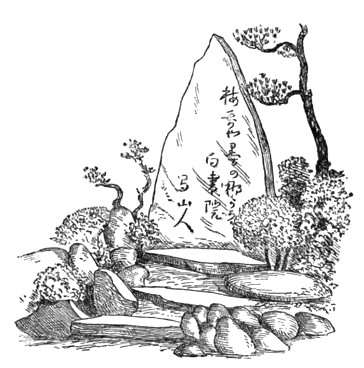 263. GARDEN TABLET The stone lanterns (ishi-dōrō) are one of the most common yet important accompaniments of garden decoration. Indeed, it is rare to see a garden, even of small size, without one or more of these curious objects. They are usually wrought out of soft volcanic rock, and ordinary ones may be bought for a few dollars. They resemble stout stone-posts of various contours, round, square, hexagonal, or octagonal; or the upper part may be hexagonal, while the shaft supporting it may be a round pillar; or they may be of irregular form, built of water-worn rock. The upper portion is hollowed out, leaving various openings cut in ornamental shape; and in this cavity a lamp or candle is placed on special occasions. They are generally made in two or three sections.  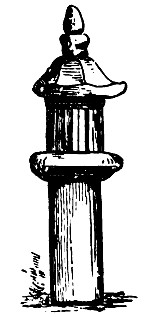 264. ISHI-DŌRŌ IN TOKIO 265. ISHI-DŌRŌ IN MIYAMA 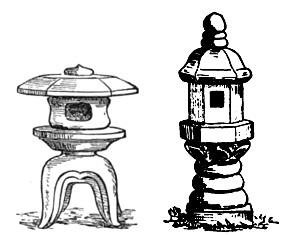  266. ISHI-DŌRŌ IN SHIRAKO, MUSASHI 267. ISHI-DŌRŌ IN UTSUNOMIYA There are at least three distinct types, — short and broad ones with tops shaped like a mushroom, these generally standing on three or four legs; tall, slender ones; and a third form composed of a number of sections piled up to a considerable height, looking like a pagoda, which, for all I know, they may be made to imitate. These stone lanterns are called ishi-dōrō. A legend states that in ancient times there was a pond on a certain mountain, in the vicinity of which robbers repeatedly came out and attacked travellers. In consequence of this, a god called Iruhiko, caused to be built stone lanterns to illuminate the roads, — stone being a more enduring material. In a temple built by Prince Shotoko, in the second year of Suiko (594 A. D.), the first ishi-dōrō is said to have been erected, and the legend states that it was removed from the region above named to this temple.1 A few sketches are here given illustrating some of the forms of Ishi-dōrō observed. The one shown in fig. 265 was sketched on the temple grounds of Miyajima, on the inland sea. I was informed by the priest there that this stone lantern was over seven hundred years old. Its base was buried, and the whole affair showed evidences of great age in the worn appearance of its various parts. Figs. 264 and 266 represent forms from Tokio and Shirako, and fig. 267 an elaborately wrought one from Utsunomiya. The little bridges of stone and wood are extremely good examples of rustic-work, and might be copied with advantage in our country. The ingenious device of displacing the stones laterally (fig. 268), or of combining the bridge with steppingstones, as seen in some of them, is decidedly unique. 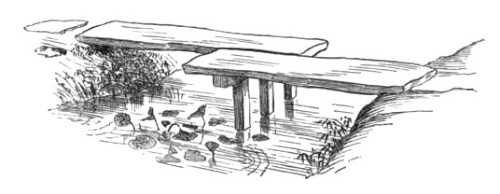 268. STONE FOOT-BRIDGE Fig. 269 illustrates a stone bridge in one of the large gardens of Tokio. The span of this bridge was ten or twelve feet, and yet the bridge itself was composed of a single slab of stone. Fig. 270 shows a little brook in a private garden in Tokio. Here the foot-bridge consists of an unwrought slab of rock. The Ishi-dōrō showing in the same sketch consists of a number of naturally-worn stones, except the lantern portion, which has been cut out.  269. STONE FOOT-BRIDGE 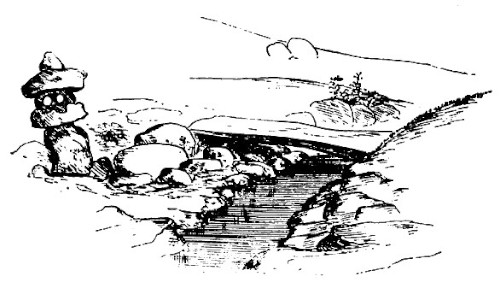 270. GARDEN BROOK AND FOOT-BRIDGE The summer-houses are simple and picturesque; sometimes they have a seat and a do-ma, or earth floor; others will have a board or a matted floor. These houses are generally open, the square thatched roof being supported on four corner-posts; others again will have two sides closed by permanent partitions, in one of which an ornamental opening or window occurs. We cannot understand what so intelligent an observer as Rein means, when he makes the statement that the Japanese garden contains no summer-house, — for it is rare to see a garden of any magnitude without one, and impossible to refer to any Japanese book on the subject in which these little rustic shelters and resting-places are not figured. The training of vines and trees about the summerhouse window is often delightfully conceived. We recall the circular window of one that presented a most beautiful appearance. Three sides of the summer-house were closed by permanent plaster partitions, tinted a rich brown color, with a very broad-eaved thatched roof throwing its dark shade on the matted floor. In the partition opposite the open side was a perfectly circular window five feet in diameter. There was no frame or moulding to this opening, simply the plastering finished squarely at the border; dark-brown bamboos of various thicknesses, secured across this opening horizontally, formed the frame-work; running vertically, and secured to the bamboo, was a close grating of brown rush. Over and around this window — it being on the sunny side — there had been carefully trained outside a vine with rich green leaves, so that the window was more or less shaded by it. The effect of the sunlight falling upon the vine was exquisite beyond description. When two or three leaves interposed between the sun's rays, the color was a rich dark green; where here and there, over the whole mass, a single leaf only interrupted the light, there were bright green flashes, like emerald gems; at points the dazzling sunlight glinted like sparks. In a few places the vine and leaves had been coaxed through the grating of rushes, and these were consequently in deep shadow. I did not attempt to sketch it, as no drawing could possibly convey an idea of the exceeding richness and charm of the effect, with the cool and shaded room within, the dark-brown lattice of bamboo and rush, the capacious round opening, and, above all, the effect of the various rich greens, — which was greatly heightened as the wind tremulously shifted the leafy screens without, and thus changed the arrangement of the emerald colors within. My attention was first attracted to it by noticing a number of Japanese peering at it through an open fence, and admiring in rapt delight this charming conception. Such a room and window might easily be arranged in our gardens, as we have a number of vines with light, translucent leaves capable of being utilized in this way. Fig. 271 gives a view of a summer-house in a private garden in Tokio. Four rough posts and a few cross-ties formed the frame; it had a raised floor, the edge of which formed a seat, and two plastered partitions at right angles, in one of which was cut a circular window, and in the other a long, narrow opening above; and crowning the whole was a heavily-thatched roof, its peak capped by an inverted earthen basin. Whether the basin was made expressly for this purpose or not, its warm red color added a pleasing effect to the gray of the thatch. In front and about it stones and rocks were arranged in pleasing disorder, while a number of exotic flowers and quaintly trimmed shrubs added their charms, and a little brook found its way across the path leading to it. 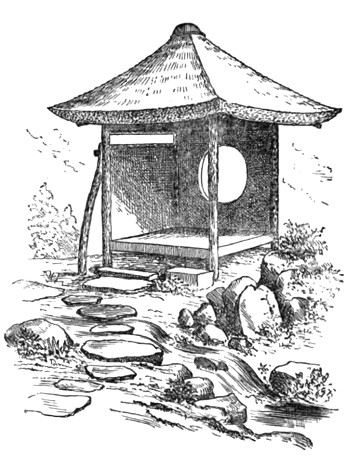 271. SUMMER-HOUSE IN PRIVATE GARDEN, TOKIO Fig. 272 is the sketch of a summer-house in one of the imperial gardens in Tokio. The frame, as in the one last figured, consisted of round sticks with the bark retained; this was capped with a thatched roof, surmounted by a ridge of thatch and bamboo. A very pretty feature was shown in the trellises, which sprung diagonally from each post, — the frame of these trellises consisting of tree-branches selected for their irregular forms. The lattice was made of bamboo and rush, and each trellis had a different design. The seat within was of porcelain; and about the slight mound on which the summer-house stood were curiously-trimmed shrubs and dwarfed pines. 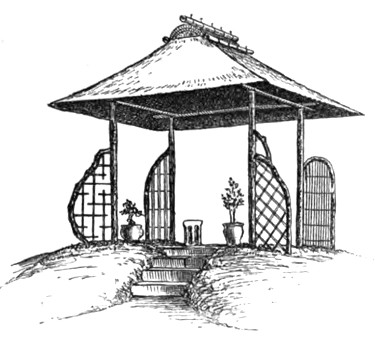 272. SUMMER-HOUSE IN IMPERIAL GARDEN, TOKIO The openings or windows in these summer-houses are often remarkable for their curious designs. The following sketches (figs. 273, 274) give a faint idea of the appearance of these rustic openings, — one representing a gourd, its frame being made of grape-vine; the other suggesting a mountain, the lattice being made of bamboo. For border hedges, trees of large size are often trained to form a second barrier above the squarely-trimmed shrubs that come next the path. A jinko-tree is trained so that it spreads like a fan, in one direction, to a width of thirty feet or more, while it may not be over two feet in thickness. An infinite amount of patient work is required in tying all the big branches and little twigs to bamboo supports in order to bring trees into such strange forms. In the garden of Fukiage, in Tokio, some very marvellous effects of landscape-gardening are seen. At a distance you notice high ground, a hill in fact, perhaps fifty or sixty feet in height; approaching it from a plain of rich green grass you cross a little lake, bridged at one point by a single slab of rock then up a ravine, down which a veritable mountain brook is tumbling, and through a rock foundation so natural, that, until a series of faults and dislocations, synclinals and anticlinals, in rapid succession arouse your geological memories with a rude shock, you cannot believe that all this colossal mass of material has been transported here by man, from distances to be measured by leagues; and that a few hundred years ago a low plain existed where now are rocky ravines and dark dells, with heavy forest trees throwing their cool shadows over all.  273. RUSTIC OPENING IN SUMMER-HOUSE, KOBE You wend your way by a picturesque forest-path to the summit of the hill, which is crowned by a rustic summer-house with wide verandah, from which a beautiful view of Fuji is got. Looking back towards the park, you expect to see the ravine below, but, to your amazement, an absolutely flat plain of shrubbery, resembling a closely-cropped tea plantation, level to the top of the hill and extending to a considerable distance, greets your eye. Have you lost the points of the compass? Walking out in the direction of this level growth of shrubbery, a new surprise awaits you; for peering through the bushes, you look down the slopes of the steep hill you had ascended. The forest-trees which thickly cover the slopes of the hill had been trimmed above to an absolute level; and this treatment had gone on for so many years that the tops formed a dense mass having the appearance, from the summer-house, of a continuous stretch of low shrubs springing from a level ground. 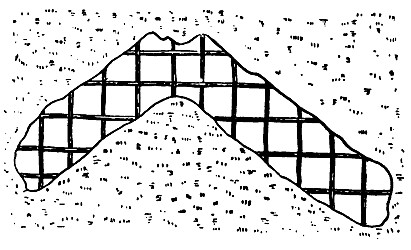 274. RUSTIC OPENING IN SUMMER-HOUSE, OKAZAKI I have spoken of the love the Japanese have for gardens and garden effects, the smallest areas of ground being utilized for this purpose. As an illustration of this, I recall an experience in a cheap inn, where I was forced to take a meal or go hungry till late at night. The immediate surroundings indicated poverty, the house itself being poorly furnished, the mats hard and uneven, and the attendants very cheaply dressed. In the room where our meal was served there was a circular window, through which could be seen a curious stone lantern and a pine-tree, the branches of which stretched across the opening, while beyond a fine view of some high mountains was to be had. From where we sat on the mats there were all the evidences of a fine garden outside; and wondering how so poor a house could sustain so fine a garden, I went to the window to investigate. What was my surprise to find that the extent of ground from which the lantern and pine-tree sprung was just three feet in width! Then came a low board-fence, and beyond this stretched the rice-fields of a neighboring farmer. At home such a narrow strip of land would in all likelihood have been the receptacle for broken glass and tin cans, and a thoroughfare for erratic cats; here, however, everything was clean and neat, — and this narrow plot of ground, good for no other purpose, had been utilized solely for the benefit of the room within. Reference has been made to the ponds and brooks as desirable features in garden-making. Where water is not obtainable for the purpose, or possibly for the ingenuity of the idea, the Japanese sometimes make a deceptive pond, which is absolutely destitute of water; so perfectly, however, are the various features of the pond carried out, that the effect of water is produced by the illusion of association. The pond is laid out in an irregular outline, around the border of which plant-pots buried out of sight contain the iris and a number of plants which naturally abound near wet shores. The bottom of the pond is lined with little gray pebbles, and a rustic bridge leads to a little island in the centre. The appearance of this dry pond from the verandah is most deceptive. The real ponds contain either lotus or other aquatic plants, or they may be given up to turtles or gold-fish, and are oftentimes very elaborately laid out with rustic, wooden, or stone bridges. Little promontories with stone lanterns standing at their ends like miniature light-houses, rustic arbors or seats, trellises above supporting a luxuriant growth of wistaria, and tortuous pines with long branches reaching out over the water, are a few of the many features which add so much to that peculiar charm so characteristic of Japanese gardens. 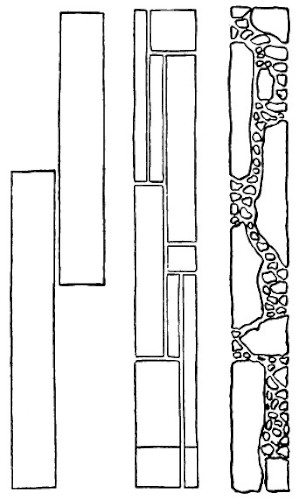 275. VARIOUS FORMS OF GARDEN PATHS The pathways of stone are of many shapes. Sometimes the slabs of stone may be finished squarely, and then each may be arranged in line across the path, or adjusted in such a way from one side to the other that a zigzag path is made; in other cases the path may consist of long slabs squarely trimmed, or of large irregular slabs interrupted with little stones, all compacted into the hard earth. Fig. 275, copied from "Chikusan Teizoden," shows some of these arrangements; and an idea of the way in which the stone paths are laid out is well illustrated in figs. 283 and 284 (pp. 291, 292), copied from the same work. The entrance from the street is seen at the left. The stone path leads through a courtyard to a second gate, and from thence to the genka, or entrance to the house.
Flowers, shrubs, and dwarf trees in pots and tubs are commonly used in the vicinity of the verandah, and also about the garden for decorative features; and here tasteful and rustic effects are sought for in the design and material of the larger wooden receptacles. Fig. 276 represents a shallow trough made from a fragment of an old shipwreck, blackened by age, and mounted on a dark wood stand. In this trough are two stones, a bronze crab, and a few aquatic plants. Another wooden flower-pot of large size (fig. 277) is made from the planks of an old vessel, the wood perforated by Teredo, and the grain deeply worn out by age. Its form permits it to be carried by two men. 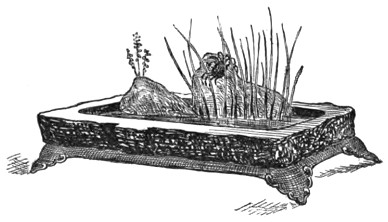 276. WOODEN TROUGH FOR. PLANTS Among the most extraordinary objects connected with gardens are the dwarf plum-trees. Before the evidence of life appears in the blooming, one would certainly believe that a collection of dwarf plum-trees were simply fragments of old blackened and distorted branches or roots, — as if fragments of dead wood had been selected for the purpose of grotesque display! Indeed, nothing more hopeless for flowers or life could be imagined than the appearance of these irregular, flattened, and even perforated sticks and stumps. They are kept in the house on the sunny side, and while the snow is yet on the ground, send out long, delicate drooping twigs, which are soon strung with a wealth of the most beautiful rosy tinted blossoms it is possible to conceive; and, curiously enough, not a trace of a green leaf appears during all this luxuriant blossoming.  277. PLANT-POT OF OLD PLANK Fig. 278 is an attempt to show the appearance of one of these phenomenal plum-trees. It was over forty years old, and stood about three feet high. By what horticultural sorcery life had been kept in this blackened stump, only a Japanese gardener knows. And such a vitality! Not a few feeble twigs and blossoms as an expiring effort, but a delicious growth of the most vigorous and dainty flowers. The pines are equally remarkable in their way. It is very curious to see a sturdy old pine-tree, masculine and gruff in its gnarled branches and tortuous trunk, perhaps forty or fifty years old, and yet not over two feet in height, and growing in a flower-pot; or a thick chunk of pine standing upright in a flower-pot, and sending out vigorous branches covered with leaves (fig. 279), and others trained in ways that seem incredible.  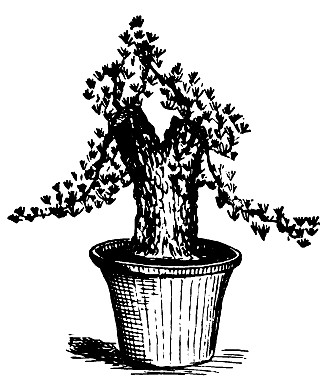 278. DWARF PLUM 279. DWARF PINE In a large garden in Tokio I saw one of these trees that spread out in a symmetrical convex disk with a diameter of twenty feet or more, yet standing not over two feet in height (fig. 280); still another one, in which the branches had been trained to assume the appearance of flattened disks (fig. 281). It would seem as if the artistic and picturesque taste of the gardener followed the shrubs even to their winter shrouds of straw; for when they are enwrapped for the winter's cold and snow, the objects even in this guise look quaint and attractive, besides being most thoroughly protected, as may be seen by fig. 282 on page 290.  280. CURIOUSLY TRAINED PINE-TREE In this brief sketch of Japanese gardens only the more salient features have been touched upon, and these only in the most general way. It would have been more proper to have included the ornamental fences, more especially the sode-gaki, in this chapter. It was deemed best, however, to include fences of all kinds under one heading; and this has been done in a previous chapter. The rustic wells, which add so much to garden effects, might with equal propriety have been incorporated here; but for similar reasons it was thought best to include with the wells the few brief allusions to water supply and village aqueducts, — and these subjects are therefore brought together under one heading in the chapter which is to follow.  281. DWARFED PINE In this chapter on gardens, I regret the absence of general sketches of the garden proper; but the few sketches I had made were too imperfect to hazard an attempt at their reproduction. Moreover, not the slightest justice could have been done to the thoroughly original character of the Japanese garden, with all its variety and beauty. In lieu of this, however, I have had reproduced a number of views of private gardens, from a Japanese work on the subject published in the early part of the last century, — though, so far as their general arrangement and appearance go, they might have been copied from gardens to be seen in that country to-day.  282. SHRUBS WRAPPED IN STRAW FOR WINTER The first illustration (fig. 283) shows the relation of the various buildings, with the approaches from the street, which is on the left. Here are seen two gateways: the larger one with swinging gates is closed; the smaller one with sliding gate is open. The building with the two little windows and black foundation is the kura. The pathway, of irregular slabs of stone, leads around the sides of the kura to a second gateway; and beyond this the stone path continues to the genka, or main entrance to the dwelling. The drawing is a curious admixture of isometric and linear perspective, with some violent displacements in point of sight and vanishing points, in order to show fully the various details within the limits of the plate. The other illustrations represent respectively a little garden belonging to the priests' house of a Buddhist temple (fig. 284), a garden connected with the house of a merchant (fig. 285; the legend says the owner is a dealer in dress materials and cottons), and a garden connected with the residence of a Daimio (fig. 286). All of these gardens were to be found in Sakai, Idzumi, nearly two hundred years ago, and the more enduring features of some of them may still be in existence. A study of these quaint drawings will enable the reader to recognize the ornamental fences, quaint rocks, rustic wells, ishi-dōrō, chōdzu-bachi, stone pathways, and curious trees and shrubs so characteristic of the Japanese garden, and so utterly unlike anything with which we are familiar in the geometrical patches we are wont to regard as gardens. 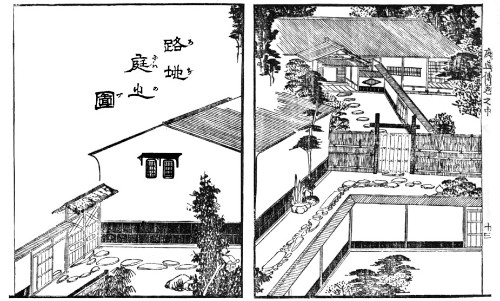 283. SHOWING APPROACHES TO HOUSE. (REPRODUCED FROM "CHIKUSAN TEIZODEN," A JAPANESE WORK) 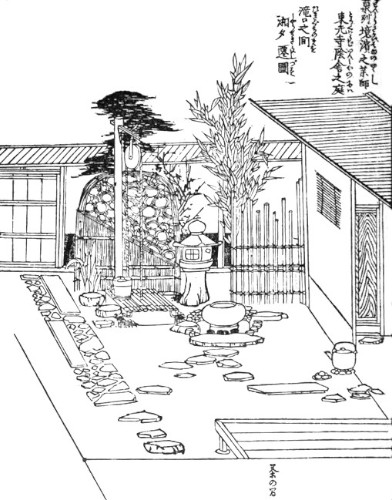 284. LITTLE GARDEN BELONGING TO THE PRIESTS OF A BUDDHIST TEMPLE (REPRODUCED FROM "CHIKUSAN TEIZODEN," A JAPANESE WORK.)  285. GARDEN OF A MERCHANT (REPRODUCED FROM "CHIKUSAN TEIZODEN," A JAPANESE WORK.) 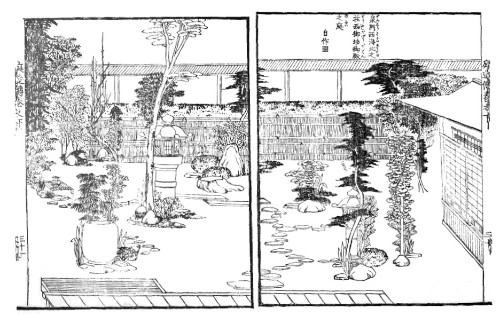 286. GARDEN OF A DAMIO (REPRODUCED FROM "CHIKUSAN TEIZODEN," A JAPANESE WORK)
It is a remarkable fact that the various trees and shrubs which adorn a Japanese garden may be successfully transplanted again and again without impairing their vitality. Trees of very large size may be seen, almost daily, being dragged through the streets on their way from one garden to another. A man may have a vigorous and healthy garden under way in the space of a few days, — trees forty or fifty feet high, and as many years old, sturdy shrubs and tender plants, all possessing a vitality and endurance under the intelligent management of a Japanese gardener, which permits them to be transported from one end of the city to the other. If for some reason the owner has to give up his place, every stone and ornamental fence, and every tree and plant having its commercial value, may all be dug up and sold and spirited away, in a single day, to some other part of the town. And such a vicissitude often falls to the lot of a Japanese garden, enduring as it is. The whole affair, save the circular well-hole, may be transported like magic from one end of the country to the other. _______________________ 1 This legend is from a work entitled "Chikusan Teizoden." |